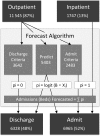Cardiac catheterization laboratory inpatient forecast tool: a prospective evaluation
- PMID: 26342217
- PMCID: PMC4954614
- DOI: 10.1093/jamia/ocv124
Cardiac catheterization laboratory inpatient forecast tool: a prospective evaluation
Abstract
Objective: To develop and prospectively evaluate a web-based tool that forecasts the daily bed need for admissions from the cardiac catheterization laboratory using routinely available clinical data within electronic medical records (EMRs).
Methods: The forecast model was derived using a 13-month retrospective cohort of 6384 catheterization patients. Predictor variables such as demographics, scheduled procedures, and clinical indicators mined from free-text notes were input to a multivariable logistic regression model that predicted the probability of inpatient admission. The model was embedded into a web-based application connected to the local EMR system and used to support bed management decisions. After implementation, the tool was prospectively evaluated for accuracy on a 13-month test cohort of 7029 catheterization patients.
Results: The forecast model predicted admission with an area under the receiver operating characteristic curve of 0.722. Daily aggregate forecasts were accurate to within one bed for 70.3% of days and within three beds for 97.5% of days during the prospective evaluation period. The web-based application housing the forecast model was used by cardiology providers in practice to estimate daily admissions from the catheterization laboratory.
Discussion: The forecast model identified older age, male gender, invasive procedures, coronary artery bypass grafts, and a history of congestive heart failure as qualities indicating a patient was at increased risk for admission. Diagnostic procedures and less acute clinical indicators decreased patients' risk of admission. Despite the site-specific limitations of the model, these findings were supported by the literature.
Conclusion: Data-driven predictive analytics may be used to accurately forecast daily demand for inpatient beds for cardiac catheterization patients. Connecting these analytics to EMR data sources has the potential to provide advanced operational decision support.
Keywords: cardiac care unit; cardiac catheterization; forecasting; hospital; patient admission.
© The Author 2015. Published by Oxford University Press on behalf of the American Medical Informatics Association. All rights reserved. For Permissions, please email: journals.permissions@oup.com.
Figures




References
-
- Bashore TM, Balter S, Barac A, et al. 2012. American College of Cardiology Foundation/Society for Cardiovascular Angiography and Interventions Expert Consensus Document on cardiac catheterization laboratory standards update: a report of the American College of Cardiology Foundation Task Force on Expert Consensus Documents developed in collaboration with the Society of Thoracic Surgeons and Society for Vascular Medicine. J Am Coll Cardiol. 2012;59:2221–2305. - PubMed
-
- Bashore TM, Bates ER, Berger PB, et al. American College of Cardiology/Society for Cardiac Angiography and Interventions Clinical Expert Consensus Document on cardiac catheterization laboratory standards. A report of the American College of Cardiology Task Force on Clinical Expert Consensus Documents. J Am Coll Cardiol. 2001;37:2170–2214. - PubMed
-
- Dehmer GJ, Weaver D, Roe MT, et al. A contemporary view of diagnostic cardiac catheterization and percutaneous coronary intervention in the United States: A report from the CathPCI Registry of the National Cardiovascular Data Registry, 2010 through June 2011. J Am Coll Cardiol. 2012;60:2017–2031. - PubMed
-
- Clark VL, Dolce J. Unplanned admissions after outpatient cardiac catheterization. Clin Cardiol. 1993;16:823–826. - PubMed
Publication types
MeSH terms
LinkOut - more resources
Full Text Sources
Other Literature Sources

